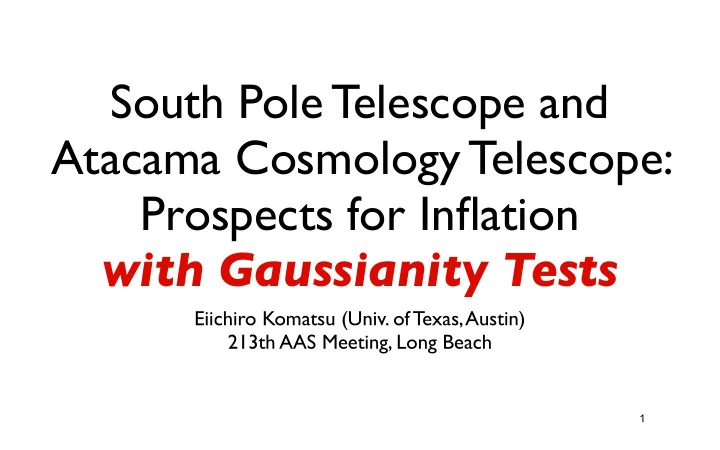

South Pole Telescope and Atacama Cosmology Telescope: Prospects for Inflation with Gaussianity Tests Eiichiro Komatsu (Univ. of Texas, Austin) 213th AAS Meeting, Long Beach 1
Center for Cosmology, The University of Texas Austin • The new Center for Cosmology, founded in January 2009, at the University of Texas at Austin! Research Unit, Center for Cosmology Astronomy Physics Volker Bromm Duane Dicus Karl Gebhardt Jacques Distler Gary Hill Willy Fischler Eiichiro Komatsu Vadim Kaplunovsky (Director) Milos Milosavljevic Sonia Paban Paul Shapiro Steven Weinberg 2
Why Study Non-Gaussianity? • Because a detection of f NL has a best chance of ruling out the largest class of inflation models . • Namely, it will rule out inflation models based upon • a single scalar field with • the canonical kinetic term that • rolled down a smooth scalar potential slowly, and • was initially in the Bunch-Davies vacuum. • Detection of non-Gaussianity would be a major breakthrough in cosmology. 3
Tool: Bispectrum • Bispectrum = Fourier Trans. of 3-pt Function • The bispectrum vanishes for Gaussian fluctuations with random phases. • Any non-zero detection of the bispectrum indicates the presence of (some kind of) non-Gaussianity. • A sensitive tool for finding non-Gaussianity. 4
k 2 k 1 f NL Generalized k 3 • f NL = the amplitude of bispectrum , which is • =< Φ (k 1 ) Φ (k 2 ) Φ (k 3 ) >=f NL (2 π ) 3 δ 3 (k 1 +k 2 +k 3 )b(k 1 ,k 2 ,k 3 ) • where Φ (k) is the Fourier transform of the curvature perturbation, and b(k 1 ,k 2 ,k 3 ) is a model- dependent function that defines the shape of triangles predicted by various models. 5
Two f NL ’s There are more than two; I will come back to that later. • Depending upon the shape of triangles, one can define various f NL ’s: • “Local” form • which generates non-Gaussianity locally in position space via Φ (x)= Φ gaus (x)+f NLlocal [ Φ gaus (x)] 2 • “Equilateral” form • which generates non-Gaussianity locally in momentum space (e.g., k-inflation, DBI inflation) 6
Forms of b(k 1 ,k 2 ,k 3 ) • Local form ( Komatsu & Spergel 2001 ) • b local (k 1 ,k 2 ,k 3 ) = 2[P(k 1 )P(k 2 )+cyc.] • Equilateral form ( Babich, Creminelli & Zaldarriaga 2004 ) • b equilateral (k 1 ,k 2 ,k 3 ) = 6{-[P(k 1 )P(k 2 )+cyc.] - 2[P(k 1 )P(k 2 )P(k 3 )] 2/3 + [P(k 1 ) 1/3 P(k 2 ) 2/3 P(k 3 )+cyc.]} 7
What if f NL is detected? • A single field, canonical kinetic term, slow-roll, and/or Banch-Davies vacuum, must be modified. • Multi-field (curvaton); Local Preheating (e.g., Chambers & Rajantie 2008 ) • Non-canonical kinetic term (k-inflation, DBI) Equil. Bump • Temporary fast roll (features in potential) +Osci. • Departures from the Bunch-Davies vacuum Folded • It will give us a lot of clues as to what the correct early universe models should look like. 8
...or, simply not inflation? • It has been pointed out recently that New Ekpyrotic scenario generates f NLlocal ~100 generically • Creminelli & Senatore; Koyama et al.; Buchbinder et al.; Lehners & Steinhardt 9
Measurement • Use everybody’s favorite: χ 2 minimization. • Minimize: • with respect to A i =(f NLlocal , f NLequilateral , b src ) • B obs is the observed bispectrum • B (i) is the theoretical template from various predictions 10
Journal on f NL • Local • –3500 < f NLlocal < 2000 [COBE 4yr, l max =20 ] Komatsu et al. (2002) • –58 < f NLlocal < 134 [WMAP 1yr, l max =265] Komatsu et al. (2003) • –54 < f NLlocal < 114 [WMAP 3yr, l max =350] Spergel et al. (2007) • –9 < f NLlocal < 111 [WMAP 5yr, l max =500] Komatsu et al. (2008) • Equilateral • –366 < f NLequil < 238 [WMAP 1yr, l max =405] Creminelli et al. (2006) • –256 < f NLequil < 332 [WMAP 3yr, l max =475] Creminelli et al. (2007) • –151 < f NLequil < 253 [WMAP 5yr, l max =700] 11 Komatsu et al. (2008)
Future Prospects • Planck satellite (to be launched in April 2009) • 1- σ error: Δ f NLlocal =4; Δ f NLequilateral =26 • C.f., WMAP5: Δ f NLlocal =30; Δ f NLequilateral =100 • Small-scale CMB (temperature) experiments • Vary f sky & l max (cosmic-variance-limited out to l max ) • Δ f NLlocal ~ 15*sqrt(0.1/f sky )*(2000/l max ) • Δ f NLequilateral ~ 120*sqrt(0.1/f sky )*(2000/l max ) • ACT: f sky ~0.025 (1000 deg 2 ); SPT: f sky ~0.1 (4000 deg 2 ) 12
Summary • ACT, SPT would yield limits on f NLlocal & f NLequilateral that are comparable to WMAP5 (and WMAP9). • A choice of l max =2000 is reasonable, considering the foreground sources such as SZ effects and point sources. • The definite limit is l max =3000 because of lensing (Komatsu & Spergel 2001). • Planck would yield much better limits. 13
Non-Gaussianity Has Not Been Discovered Yet, but... • At 68% CL, we have f NL =51 ±30 (positive 1.7 σ ) • Shift from Yadav & Wandelt’s 2.8 σ “hint” (f NL ~80) from the 3-year data can be explained largely by adding more years of data, i.e., statistical fluctuation, and a new 5-year Galaxy mask that is 10% larger than the 3-year mask • There is a room for improvement • More years of data (WMAP 9-year survey funded!) • Better statistical analysis ( Smith & Zaldarriaga 2006 ) 14 • IF (big if) f NL =50, we would see it at 3 σ in the 9-year data
Recommend
More recommend